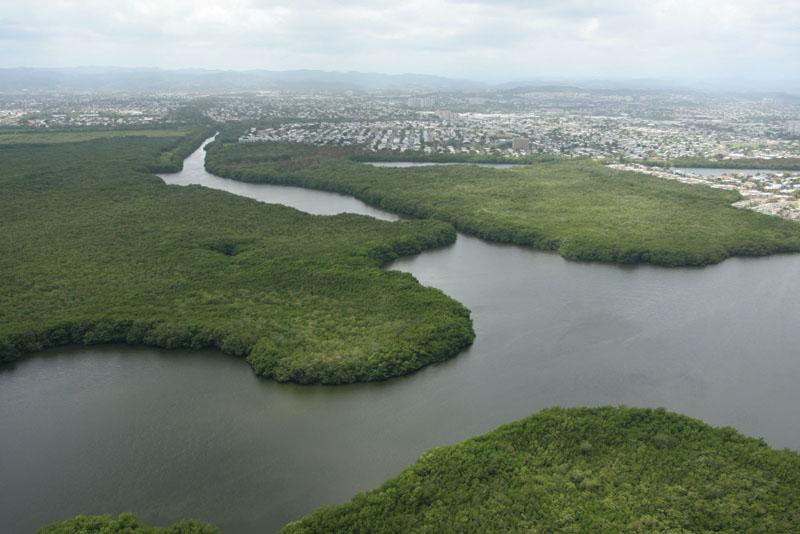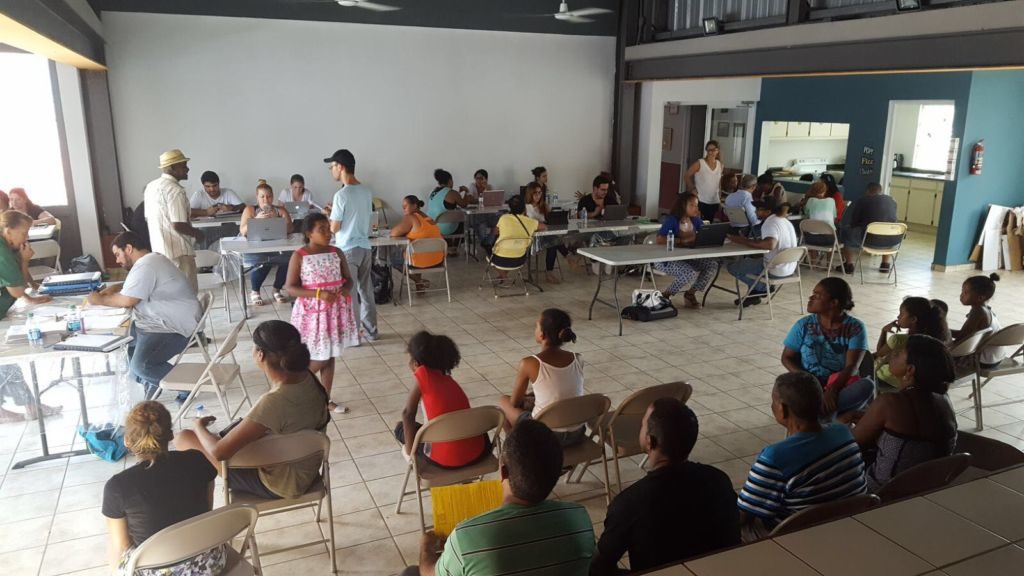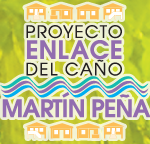
The Caño Martin Peña connects San Juan neighborhoods with the San Juan Bay National Estuary. Photo provided by the Environmental Protection Agency (EPA).
El Caño Martin Peña
El Caño Martin Peña (CMP) is a 3.75-mile-long tidal channel located within the San Juan Bay National Estuary in Puerto Rico, the only tropical estuary within the National Estuary Program.
In the 1930s and 1940s, San Juan experienced a vast, rapid emigration of people from rural areas in search of a better quality of life. The result was substandard dwellings built in the mangrove wetlands bordering the channel, with refuse and debris used as fill material. The eight communities bordering the CMP has a long history of poverty, marginalization, blight, unsafe living conditions, and exposure to significant environmental and health hazards, despite their privileged location within the San Juan Metropolitan Area next to San Juan’s financial district.
The eastern half of the CMP, historically between 200-400 feet wide, is currently clogged with sediment, debris, and waste, obstructing the hydraulic flow between the San José Lagoon and the San Juan Bay.
Over 3,000 structures still discharge raw sewage into the remains of the channel. The lack of adequate sewer and storm water systems has led to major flooding (often up to six feet spilling into homes), exposing 26,000 residents in the eight communities surrounding the channel to polluted waters and sediments.
- Caño Martín Peña at Israel and Bitumul communities where sewage flows into the channel. Photo provided by the EPA.
- This sign reads, “El Caño es tuyo. Protegelo!” or, in English, “The Caño is yours. Protect it!”. Photo provided by the EPA.
How ENLACE Formed
In 2002, the CMP and its neighboring communities were designated as a special planning district due to the degradation of the channel and its impacts. Over 700 participatory planning activities over the next two years led to the Puerto Rico Law 489 of September 24, 2004 which, as amended, was approved unanimously by all parties in the legislature, and provided the foundation for the Comprehensive Development and Land Uses Plan for the Caño Martín Peña Special Planning District (CMP District Plan). The Corporación del Proyecto ENLACE del Caño Martín Peña (ENLACE) was created by Law 489 with the mission to oversee and implement the CMP District Plan.
ENLACE works closely with the Grupo de las Ocho Comunidades Aledañas al Caño Martín Peña (G-8), Inc., a non-profit organization comprising twelve grassroots organizations, whose goal is to ensure the participation of residents in the decision making processes of the District as well as prevent the involuntary displacement and gentrification of these communities. ENLACE and the G-8 also work with the CMP Community Land Trust, a novel mechanism that has been fundamental to allow for the improvement of the area without creating an economic barrier for the residents, in part by providing opportunities for families to relocate within their own communities.
Health and Environmental Justice
Because the channel is clogged with debris, sediment, and organic waste, the water is often stagnant. Lack of storm drain systems combined with the blocked channel results in frequent wastewater flooding. Residents are constantly exposed to high concentrations of fecal coliform bacteria and other contaminants within the stream. To combat this, ENLACE led a community-based, participatory process to design a new Storm Sewer System, separate from the sanitary sewer system. Components for a separate storm sewer system include water and soil quality improvements to reduce pollutant loads, green infrastructure initiatives, and considerations related to challenges presented by climate change. This new storm sewer system combined with channel dredging by the U.S. Army Corps of Engineers (USACE) will decrease the amount of debris and decrease the frequency of flooding.
The degraded channel has threatened not only communities’ health, but the ecosystem as well. ENLACE engages in public education activities to promote an understanding of the impacts of environmental degradation, fostering critical consciousness and democratic action to support restoration efforts. The restoration of the estuarine tidal channel will allow for mangroves to flourish and increase biodiversity, improving resilience during storms and providing opportunities for tourism. Engaging the community in this work fosters more support for ENLACE’s work and empowers citizens to stand up for themselves in the face of environmental justice challenges. The surrounding communities are standing up for their right to a healthy ecosystem and for the improvement of their own health.
- Public education projects engage both youth and adults. Photos provided by ENLACE.
ENLACE Successes/Formation of the Urban Waters Federal Partnership (UWFP)
Community participation is how ENLACE formed, and it is that which is transforming the communities around the channel and the channel itself. The collaboration of ENLACE and the San Juan Bay Estuary Program paved the way for the CMP to become a designated Urban Waters location in 2013. Now, sixteen federal partners, ten Puerto Rico Agency partners, the Municipality of San Juan, and thirteen NGO partners are working together toward the common goal of transforming the channel into an asset for local communities.

A crucial part of ENLACE is the establishment of a community land trust, to inoculate against gentrification through collective ownership of land. Photo provided by ENLACE.
Addressing the health and environmental challenges of the channel and its surrounding communities is no easy task. The partners acknowledge that expanding the support of the CMP project to encompass different levels and sectors is necessary, and so are continuing to use the communities’ input for their projects. With projects such as reconnecting the CMP to the San Juan Bay, developing a broader vision for the dredging of the channel, improving infrastructure and housing, and fostering socioeconomic development, the UWFP is ensuring that they improve the ecosystem while balancing the communities’ needs.
Because of better communications and collaborations between various federal, state and local partners involved in the Federal Partnership, ENLACE has completed or is conducting the following:
- Caño Martin Peña Ecosystem Restoration Project, which includes the development of the Feasibility Report (approved on May 2016): the first step in achieving major dredging to restore water flow within the channel and improve water quality within the estuary
- Solid waste collection trucks provided by local government for community-based recycling
- Martin Peña Health Impact Assessment (2014) in partnership with Icahn School of Medicine at Mount Sinai: ENLACE conducted a health impact assessment of the environmental restoration of the CMP, the first known health impact assessment to be conducted in Puerto Rico
Lessons Learned in the Aftermath of Hurricane Maria

Residents apply for individual assistance from FEMA at El Centro de Buena Vista. Photo provided by ENLACE.
Because of a history of engagement and an established communication network, the CMP communities were able to mobilize rapidly and effectively in response to the disaster. They had already acquired some needed equipment, such as water pumps, and so were able to mitigate hazardous flood conditions. Community leaders acted as first responders, quickly assessing the damages and communicating to authorities about immediate financial and material needs—such as tarps to replace over 800 roofs and mosquito nets, repellants, and larvicides. G8, ENLACE, and El Fideicomiso de la Tierra worked together with over 600 volunteers over two months to clear debris, repair damaged houses, install three solar-powered community centers, and prepare 5,000 hot meals. Pre-established unity and organization were extremely important, since over seventy-five CMP families lost their homes to Maria, and many residents had to seek shelter with their neighbors.
The storm highlighted concerns ENLACE has been expressing for years — including the need for built, electrical, and communication infrastructure. Storms like Maria will become more frequent in coming years, and a cleared and open channel is vital for the long term resilience and health of CMP communities. Maria’s impacts underscored the urgency of these priorities.
Lessons for the Federal Partnership and UWLN Members
When providing resources and assistance during and in the aftermath of disasters, it is vital to assess and respond to the immediate needs of affected communities. During and after Maria, over 70% of CMP communities were flooded by contaminated water, so one of the most urgent concerns was water quality. Communities experiencing drastic flood events and exposure to flood-borne pollutants often do not have the means to conduct water quality testing or treatment, and may not have access to potable water. A larger network with directory information for groups or experts that could provide aid in this area—such as accessible methods of research, water treatment and filtering, disease prevention, and the like—would be helpful for those who cannot access this kind of information or resource in a disaster situation. Further networking on a national scale around identification and mobilization of expertise is one way to help communities to become more resilient in the long term. In the short term, it is important to support on-the-ground organizations that are directly servicing the immediate needs of the community.
On the national level, mainland individuals and groups should use their voices to advance policies in favor of addressing environmental and social issues, long-term resilience, and short- and long-term relief efforts, since U.S. territories do not have the ability to directly influence federal elections and policies.
Resources and Further Reading
Documentary: Agua Mala (Caño Martín Peña), or “Bad Water”: video of ENLACE work
Images of the Caño Martin Peña and the ENLACE tour of CMP Communities on 11/16/2016
Please support Maria recovery efforts through Global Giving.








